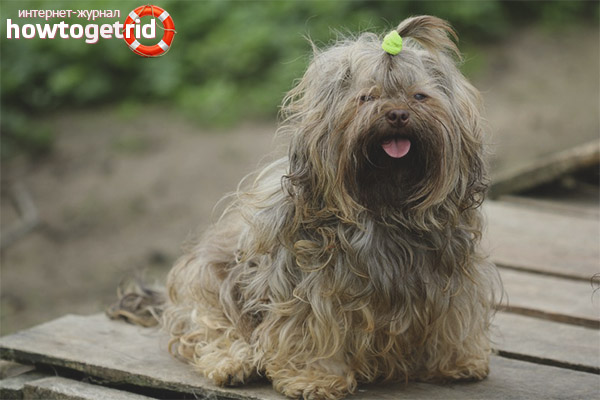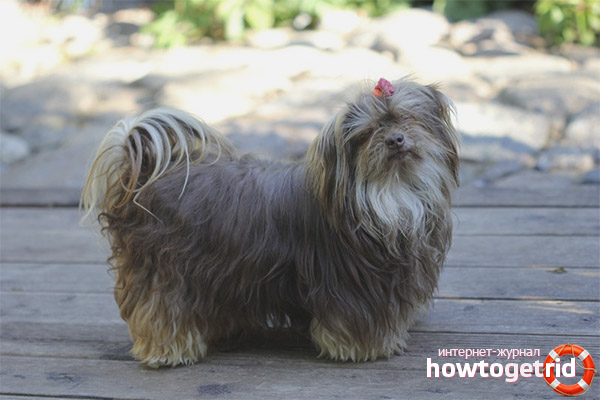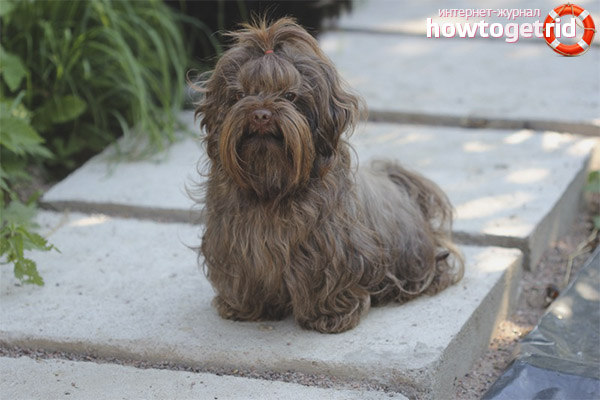The content of the article
The Russian colored lapdog, as the name implies, was deduced by the breeders of our homeland. In appearance, the dog is somewhat reminiscent of a toy, so cute and disheveled. The lap-dog has many followers who want to get a pet and grow it as a faithful member of the family. It was for them that we compiled today's material affecting traits of character, as well as generally accepted breed standards. Let's take a closer look so that you can draw certain conclusions for yourself.
Features and external data of the breed
- It is interesting that the International Kennel Federation has still not recognized the Russian lapdog as an independent breed. However, this does not prevent pets from growing in number, surrounding themselves with toy dog lovers.
- It should be immediately noted that the lap-dogs in their description are constantly being corrected. It is possible that the following characteristics will soon change, and more than once. Fans of the breed presented are seriously determined to bring Russian lapdogs to the international level, so that they are finally recognized.
- The Russian lap-dog is a small dog that is not inferior to its relatives in the physique and proportional strength. In terms of format, individuals are slightly elongated, but the body length does not exceed the indicators from the floor to the withers by more than 15%.
- Looking at the puppy, it is difficult to understand what it will be like in the future. But an adult dog should look spectacular, expensive. Breeders pay due attention to the quality and characteristics of the coat. However, in pets with an age category of up to 1 year 3 months, deviations in the composition of the coat can be observed, which will disappear in the future.
- According to Russian standards, lapwings and their sizes are subject to strict regulation. At the withers, the dog should not exceed 26 cm, regardless of whether it is a bitch or a dog. As for body weight, it is usually 3-4 kg. depending on the fatness and physical activity of the pet. It is important to know that a dog that is 28 cm tall is disqualified. She will not be allowed to engage in breeding activities and an exhibition career, but such an individual has proven itself as a pet.
- For breeding, lap-dogs that exceed the declared specifications by standards are not suitable. But small dogs can participate in breeding activities. However, bitches will not be allowed to do this; they must be properly folded in order to independently bear and give birth to offspring.
- According to external data, the Russian lapdog resembles a toy dog. She has friendly and interested eyes, the dog is focused on constant communication with a person. Likes hair care, combing. The dog is kind by nature, any manifestations of aggression in relation to the owner indicate deviations in the psycho-emotional environment.
Breed standards
- Head. Overgrown with wool, in its composition is not heavy, but weighty and massive. The head is proportional to the body, moderately strong. The frontal part is not too prominent, spacious and slightly convex. For the defect of the breed, slanting and excessive plane will be considered. The occipital region is almost not visible, weakly expressed. The arches above the eyebrows stand out, but because of the long falling hair, they are poorly visible. The skull as a whole should not burden the overall build of the dog.
- Muzzle. Passes into the frontal section noticeably, short and in-depth. For the lack, they will consider the smoothness of the transition area of the forehead to the muzzle. The muzzle takes up a third of the total size of the head. If it is too long, this is a defect.The nose is quite wide, straight, moderately massive. The muzzle is narrowed to the nose, but not pointed. The chin is expressed well, not weighty. The cheekbones are almost not visible. Lips of a dry structure, pressed to the jaw tightly enough. They are thin, elastic. There is dark pigmentation on the lips, it is black, but other shades are acceptable to match the color of the animal.
- Eyes. Round in shape, do not bulge, but also do not flow. Medium sized buttons. Equally set, the dog looks friendly, the look is studying and interested, a little playful. There is a certain sparkle in the eyes. The irises are pigmented in dark color as much as possible. But in representatives of the breed with a brownish coat, the iris can be highlighted. A defect is considered to be bulge, heterochromia, blue eye shade. Eyelids of a dry structure, fit tightly, hide the protein part of the eye, if the pet has fixed its eyes in front of itself. Usually the eyelids are pigmented in black, but can be dark brown.
- Nose. Small in shape, but very sensitive and agile. The nostrils of the animal are slightly rounded, open. The nose is set vertically, black, but other shades suitable for the coat are allowed. Under an indisputable defect that will not allow the animal to the show career, a locally pigmented nose is considered. It should be monophonic, no other way.
- Teeth. Healthy, complete, white, even. Cutters are placed in parallel, tightly fixed. As for the bite, it is not allowed that one jaw protrudes forward. Bite in the form of "scissors" or "wedge" (straight). If there is not even one incisor, this will be considered a serious defect. The same applies to the bite of the jaws, between which there is a gap. A similar situation is with asymmetry and overshot.
- The ears. With rounded tips, in the shape of a triangle. They have an average size, are lowered to the skull. Landing is not very high. Puppies may have less hair, but for adults, overgrown ears are a must. According to standard characteristics, ears are not allowed to stand upright or be half raised.
- Tail. The length is standard, nothing outstanding. Reaches hock joints, set high. If the tail is short in nature, then this is only possible due to a cross between two breeds. This means that the dog is not purebred, this will be considered a defect. As for the general position, the tail is twisted into a ring, can be pressed to the thigh or lie on the back. Significant disadvantages include the presence of nodes and creases. With such defects, the breeding value of the animal is in deepest doubt. If the dog is adult, overgrown, respectively, and her tail should be covered with a sufficient amount of hair.
- Body. Slightly elongated rectangle format, not wide, compact. According to generally accepted standard characteristics, the dog should not look stretched, this is a vice. The same can be said for square addition. Neck set high, proud with a prominent scruff. It is dry, but muscular and oval in shape. The chest is developed, moderately deepened, proportional. The withers are clearly visible, the back is muscular and strong, sloping. Croup, beveled, rounded. Groin tightened medium. In general, representatives of the breed look harmonious, and not ridiculous.
- Limbs. The considered body parts in the animal are proportional and quite strong. The correct structure of the limbs in the dog allows it to move freely and easily. Nothing will interfere with the pet during active games and training. The front legs are quite strong and set in parallel, not widely. The animal’s shoulder blades have good musculature. They are drawn to the body. The shoulder blades form an open angle. If the breed has a shortened forearm, this is considered a serious flaw.The shoulders should be flat and aligned with the shoulder blades. Strong elbows are directed strictly back. Forearms of proportional length, sheer, like wrists. The latter are quite strong and set parallel to the forearms. Five are delivered almost vertically, they are flexible. The back setting of the paws is slightly wider, they are also powerful. The hips have developed muscles. They do not differ in large length, while set at a slight angle.
Color and type of coat
- The wool of a Russian lap-dog is considered to be its pride and distinctive feature. The skin is quite thin and elastic. In this case, the dog has no folds. The pigmentation of the epidermis is dark and, as a rule, corresponds to the color.
- In adulthood, pets acquire a full and thick undercoat. If the latter is absent from the dog, this is considered a gross deficiency. The outer hair has increased strength and density. It is heavy enough, healthy and shiny.
- To the touch, the coat of the animal is quite smooth, soft and silky. The hair structure of the lapdogs is wavy. Curls in this case should be pronounced and large enough. The disadvantage is thin, straight and weak outer hair.
- Also, a significant deviation from the breed standard is the lack of rich vegetation on the head, regardless of gender, season, or age of the animal. Also at exhibitions, the color of the pet is strictly evaluated.
- If there are any deviations from the general norms, the dog will be disqualified and discarded for further breeding. Standards include all plain colors except white. Not so long ago, a color called Rime was admitted to the standards. It looks like frost that covers the main color.
- It is also worth paying special attention to the color when choosing a pet. White spots should not be present, such a feature is undesirable. To serious deviations from the standards, white socks or a large white spot on the chest area are recognized.
Training and character
- The breed in question is intended for an experienced dog breeder who has a strong and stable psyche.
- Each lap-dog has a unique character and its own characteristics. These dogs are quite affectionate, outgoing and friendly. The breed is very attached to the owner, while the animal does not impose its communication.
- If the pet is socialized in time, it will be very sociable. Such a dog will be an excellent member of the family.
- Bolonki get along well with children. Also, the breed is indifferent to other animals and gets along well with cats. Therefore, you can easily get exotic animals or birds.
Russian lapdog will be an excellent four-legged member of the family. The dog is not prone to strong molting. The pet has excellent health and friendly disposition. With timely education and early socialization, the animal will not cause any additional problems. If the dog is properly trained, it will always obey the owner. When choosing a puppy, all standards should be considered. If you do not have any experience, it is worth contacting a dog handler for help.
Video: Russian color lapdog












Submit